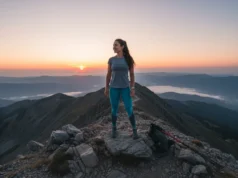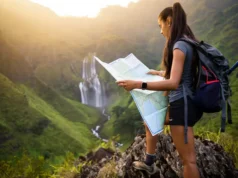In this article
Popular hiking apps are incredibly convenient, but the most rewarding hiking experiences often lie on unique, less-crowded local trails waiting to be found. While 57.8 million hikers in the US use apps to make hiking more accessible, this guide will provide a diverse toolkit to help you become a self-sufficient trail discoverer. We’ll explore the “AllTrails effect”—the tendency for apps to funnel people onto the same crowded paths—and offer a strategy to move beyond a single platform. The process of discovery is an adventure in itself, and this guide will help you develop a “discovery mindset” for all your future hikes.
The “AllTrails Effect”: Why Diversifying Your Toolkit is Crucial
Relying only on major, algorithm-driven platforms for finding a trail comes with specific limitations. Depending on a single source can negatively impact your hiking experience and the environment, making a clear case for why you should broaden your search methods to find the best local trails beyond algorithms.
Understanding Overcrowding and Environmental Impact
The primary drawback of a single popular hiking app is the concentration of millions of users onto a limited number of highlighted trails, leading to congestion. This “AllTrails effect” directly impacts the solitude many a hiker seeks and can degrade the trail environment through overuse. Heavy foot traffic leads to issues like trail widening, soil erosion, and stress on local ecosystems, creating a sub-optimal hiking experience for everyone.
By seeking out lesser-known trails, you can practice a more distributed form of recreation that alleviates pressure on these popular “honeypot” sites. This approach contributes directly to the long-term sustainability of our shared outdoor spaces. Beyond the environmental harm, crowded trails diminish the personal experience. The noise and congestion can detract from the feeling of immersion in nature, which is a primary reason many of us go on a hike in the first place. Learning the skills for finding the trail less traveled is a gift to yourself and the landscape.
The Limits of Algorithm-Driven Discovery
Algorithms on large platforms primarily surface trails based on popularity metrics. This system is effective for finding a well-regarded or popular hike, but it creates a feedback loop where popular trails become even more so, while hidden gems remain undiscovered. These algorithms may overlook different trails with unique features, such as historical significance, specific plant life, or profound solitude.
Hikers seeking these specialized attributes may find mainstream apps don’t cater to their needs. Furthermore, there are reliability concerns with user-generated, crowd-sourced content. Information from the AllTrails map regarding conditions, difficulty, or even land access can be inaccurate or outdated, a source of common frustrations with app updates. This is why comparing features of free hiking apps is a good step to understanding which platform best suits your planning style.
Foundational Discovery: Tapping into Official & Local Wisdom
To find the most authoritative and reliable trail information, turn to the source: government agencies and local experts. This foundational layer of research provides the ground truth that all other digital tools should be cross-referenced against for safety and accuracy on your trip.
Consulting Government & Land Management Websites
The federal agencies managing public lands are the most authoritative sources. The National Park Service (NPS), U.S. Forest Service (USFS), Bureau of Land Management (BLM), and managers of any National Recreation Area offer dedicated websites with detailed trail maps and up-to-date alerts. The USFS manages over 164,000 miles of trails, and their official website provides a fantastic National Forest interactive visitor map. Always verify that trails are official system trails.
Don’t forget state and local sources for particular areas. Search for your state’s “Parks and Wildlife” websites, as well as local county and city park sites. These are often goldmines for well-maintained paths close to home and provide critical updates from the National Park Service or other agencies about the land you want to see.
The Power of Human Intelligence: Rangers and Local Clubs
The human expertise found at visitor centers and ranger stations is irreplaceable. Park rangers possess the most current, real-time intelligence on trail conditions, temporary closures, and can offer personalized recommendations based on your ability. Rangers are often out on the trails daily, giving them direct, firsthand knowledge that you won’t find online. Learning about The backcountry life of a park ranger shows just how connected they are to the mountains and forest.
Local hiking clubs and outdoor organizations are another fantastic way to tap into a collective well of trail wisdom. These groups organize hikes and maintain trails, sometimes including famous routes like the Appalachian Trail. They are hubs for nuanced local knowledge that never makes it into an app’s trail guides. Many clubs serve specific communities; joining not only helps you find interesting places but also connects you with the local outdoor community.
Mastering the Map: Your Compass to Uncovering Hidden Trails
The timeless skill of map reading will empower you to find your own way. Understanding topographic maps—both paper and digital—allows you to move from being a passive follower to an active explorer of the landscape, capable of identifying potential routes that algorithms always miss.
How to Read a Topographic Map for Trail Discovery
Topographic maps are superior because they reveal the three-dimensional shape of the terrain using contour lines. Each line connects points of equal elevation, making it the single most important feature for assessing a potential route. Knowing how to read a topographic map is a core hiking skill for all explorers.
Interpreting these lines is straightforward: when lines are close together, the terrain is steep; when they are far apart, the slope is gentle. You can identify key features like peaks, valleys, and important landmarks, which helps in spotting potential unofficial paths. Other critical map elements include the scale for judging distance and the legend for understanding symbols. This knowledge is central to mastering navigation with a map and compass.
Using Digital Mapping Tools for Exploration
Powerful digital mapping tools build on these same principles. Google Earth provides exceptional 3D visualization, allowing you to perform a virtual “fly-over” to spot faint traces of an old woods road or clearings not visible on a 2D map. While Alltrails, Gaia GPS, and Avenza are all worthy hiking apps, advanced tools like Gaia GPS and CalTopo are favored by experienced hikers for meticulous planning. These tools provide access to an incredible array of map layers.
These include various topo series, satellite imagery, and even crowd-sourced maps from a community-driven mapping project like OpenStreetMap. With these tools, you can draw and analyze custom routes, check elevation profiles, and export GPX files. They are particularly useful for planning off-trail adventures or exploring complex areas with a full map.
How to Find the Best Day Hikes for Your Adventure
Finding trails that match your personal criteria requires actionable strategies. You can learn how to discover less-crowded, dog-friendly, or beginner-appropriate hikes by moving beyond generic searches and applying a strategic filter to your discovery process.
Seeking Solitude: Finding Less Crowded Trails
The easiest way to find solitude is to manage your timing. Hike on weekdays, during the off-season, or start very early to beat the crowds. Another effective strategy is to increase the “effort barrier.” Hikes that are longer, have more elevation gain, or are located down a rough dirt road will naturally have fewer people. Learning how to find off the beaten path hiking trails is about being strategic.
You can also use topographic maps to identify less-obvious connector trails or parallel routes that others overlook. It is also wise to actively avoid destinations currently trending on social media. These “hotspots” are guaranteed to be congested, so looking elsewhere is a primary strategy to find peace and quiet and avoid crowded trails.
Paws on the Path: Locating Dog-Friendly Trails
The first and most important step is to always check the official websites of the land managing agency (NPS, USFS, State Parks). These sources provide the definitive rules on where dogs are allowed. While some apps have “dog-friendly” filters, their reliability can be inconsistent. Use them as a starting point, but always cross-reference with the official land manager’s policy before you go.
Tap into community knowledge by joining local dog owner groups. These communities are excellent for verified trails and practical advice on conditions like water availability from a creek or trail surface suitability for paws. Thinking about factors like shade, water access from a nice waterfall, and terrain is key. As an example, there are great resources online that compile lists of dog-friendly hikes in Sedona.
First Steps: Identifying Beginner-Friendly Routes
Good beginner-friendly routes share key characteristics: shorter distances, minimal elevation gain, a well-maintained surface, and clear signage, making for an easy hike. Treat difficulty ratings on apps with caution. Always cross-reference a rating like “easy” with objective data like distance and elevation to get a true sense of the effort required. You can even learn how to determine hiking difficulty using official park guidelines.
Official park resources are the best starting point for new hikers. State and local park websites often highlight their easiest trails, which are perfect for building confidence. Visitor center staff are also an excellent resource. They can provide tailored recommendations to ensure a positive first experience, helping you find genuinely beginner-friendly trails.
Hike Smarter: Essential Trailcraft and Safety
Finding the perfect trail is only the first half of the adventure; enjoying it responsibly and safely is paramount. Accurately assessing difficulty, understanding the ethics of Leave No Trace, and carrying the right gear are non-negotiable skills for any competent, self-reliant hiker.
Decoding Trail Difficulty Beyond Simple Ratings
A thorough assessment of a trail’s difficulty goes beyond subjective labels and involves looking at hard data. The key factors are distance, elevation gain, steepness (gain per mile), and the type of terrain (steep terrain, rock surfaces, etc.). For instance, a trail that gains 1,000 feet in one mile is vastly more challenging than one gaining 1,000 feet over five miles. This metric is a powerful indicator of a trail’s true difficulty for different skill-level hikers.
Some agencies even use a numerical formula for a more objective rating, which illustrates an analytical approach to assessing a hike’s challenge level. Topographic maps are invaluable here. By looking at contour line density, you can visually gauge the steepness of a trail section, like a climb to a lookout, before you ever set foot on it.
Leave No Trace: The Hiker’s Code of Ethics
The Leave No Trace principles are the fundamental code of ethics for all outdoor activity, especially when exploring less-common paths or potential herd paths that may be ecologically sensitive. The first principle, “Plan Ahead and Prepare,” ties directly back to everything we’ve discussed. A key part of that preparation is adhering to Leave No Trace principles with the right gear. The principle of “Travel on Durable Surfaces” means staying on the established trail.
“Dispose of Waste Properly” means packing out everything you pack in. “Leave What You Find” means preserving natural objects and cultural artifacts for others to enjoy. By internalizing all seven principles, including respecting wildlife and being considerate of others, you become a steward of the places you discover. For a complete overview, you can review The Leave No Trace Seven Principles directly from the National Park Service.
Navigation Know-How and Staying Safe
Even in the age of GPS, knowing how to use a physical map and compass is a critical backup skill. Electronics can fail, making this analog knowledge a non-negotiable part of being a self-reliant hiker on any of your travels. You should Always carry the Ten Essentials, which are safety systems, not just individual items. They include categories like Navigation, Sun Protection, Illumination, First-Aid, and Emergency Shelter.
Always leave a detailed itinerary with a reliable person, including your planned route and when you expect to be back. This is one of the most important Wilderness safety tips from Search and Rescue teams. Always check the weather, search for area closures, and know your limits—be willing to turn back if conditions worsen.
Conclusion: Your Journey to Amazing Local Hikes Starts Now
Moving beyond a single app and embracing a diverse toolkit (official sources, maps, community wisdom, and other guides) transforms you into a confident, active discoverer. The process of discovery is a rewarding adventure that fosters a deeper connection to your local environment and builds lifelong skills. This approach is also a sustainable form of adventure, cultivating stewardship for the natural spaces in your own backyard. We encourage you to use these strategies to find your next great hike while always prioritizing safety, planning, and Leave No Trace ethics.
Frequently Asked Questions about Finding Local Hiking Trails
What is the best free alternative to AllTrails for finding reliable trail information? +
How can I know if a trail is going to be crowded before I go? +
Are the maps on hiking apps accurate enough for navigation? +
How do I find trails that might not be on any app at all? +
We are a participant in the Amazon Services LLC Associates Program, an affiliate advertising program designed to provide a means for sites to earn advertising fees by advertising and linking to Amazon.com. As an Amazon Associate I earn from qualifying purchases. We also participate in other affiliate programs. The information provided on this website is provided for entertainment purposes only. We make no representations or warranties of any kind, expressed or implied, about the completeness, accuracy, adequacy, legality, usefulness, reliability, suitability, or availability of the information, or about anything else. Any reliance you place on the information is therefore strictly at your own risk. Additional terms are found in the terms of service.





